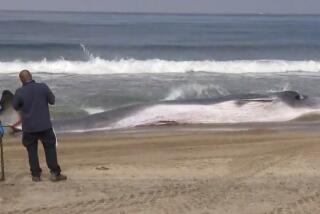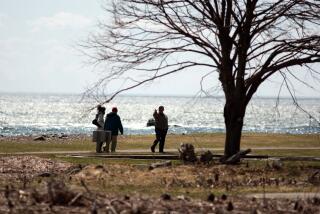Atlantic Ocean Becoming the Wrong Place for the Right Whales
ABOARD THE RESEARCH VESSEL HALOS — This converted lobster boat sits idle off the Massachusetts coast, bobbing in choppy waters as the skies darken. Its crew searches the horizon for one of the rarest sights on Earth.
The only sounds are the waves sloshing against the hull and the squeals of a yellow-necked gannet overhead.
Then, to the starboard, plumes of water spurt skyward and a “whoosh!” echoes in the damp, cool air off Cape Cod Bay.
“I think that’s Stripe!” calls out Scott Kraus of the New England Aquarium.
This is an old friend. Aquarium records say Stripe is a 45-foot grandmother who has delivered at least seven calves since 1967. She now accompanies her youngest: a 22-foot male born late last year who “skim feeds” with gaping jaws up to 150 pounds of tiny crustaceans an hour.
They are North Atlantic right whales, whose names tell of their history as a species of whales: They were “right” for hunting--slow, surface dwellers who floated when killed and yielded large quantities of baleen, or whalebone, and blubber.
Thanks to the ecology movement, 300 of them survive. But they face danger anew.
Witness Stripe’s calf who, shortly after being spotted by the researchers, starts swimming toward their boat. He stops about 10 yards away and wriggles playfully on his back, his tail slapping the surface. He is like a puppy rolling in the grass.
A century ago, this friskiness invited death from a whaleman’s harpoon. Now it invites death from a new enemy--the bows and propellers of ships.
This year has been an especially deadly one for the species. At least six right whales have washed up on the shores of Florida, Georgia and Massachusetts since January, three times the number for all of 1995.
At least three of those six deaths resulted from collisions with ships, prompting researchers to label vessels the harpoons of the 1990s. Without corrective action, the only right whales in the future will be the images on Massachusetts license plates, experts say.
“You could very well see the extinction of this species in our lifetime,” says Kraus, who oversees the aquarium’s right whale research program.
The unintentional hunters now are the oil supertankers, those behemoth cargo ships and barges plying the seas. Since 1970, at least 14 of the 42 right whale carcasses, or 33%, found along eastern North America resulted from ship collisions, the National Marine Fisheries Service says.
“Our shipping is an issue and always has been,” says Doug Beach, protected species coordinator for the fisheries service in Gloucester, Mass. “That’s got to be stopped. What we’re going to have to do is remove man’s impact from the animal.”
The fisheries service is attempting to do that through a public-private network stretching from Canada to Florida. The network uses aerial surveys, Cold War technology, revenues from license plates, 35-millimeter cameras and binoculars in Florida’s Space Coast condominiums.
“The right whale is one of the two marine mammal species given the highest priority,” says P. Michael Payne, head of the agency’s marine mammal division, which spent $950,000 on right whales last year. “What happened this year made us more aware of what we need to be doing.”
Right whales have been on Earth at least 10 million years, twice as long as humans. They can reach 55 feet, weigh 70 tons and live more than 50 years.
The peak of the right whale fishing industry was 1851, when about 10.3 million gallons of oil from about 5,450 whales were harvested by ships from Massachusetts, Connecticut, Rhode Island and New York.
A typical right whale yielded up to 600 pounds of baleen--the bristly food strainers converted to corsets and parasols--and 1,890 gallons of oil for lamps, lubricants and soaps.
In his 1907 work, “A History of the American Whale Fishery,” Walter Tower wrote, “The foundation of many a stately old mansion in New England rests on ‘oil and bone.’ ”
But writer Herman Melville considered the right whales “an inferior article in commerce” that were killed while looking for sperm whales.
“I wonder what the old man wants with this lump of foul lard,” one of Captain Ahab’s mates says in “Moby Dick.”
Right whales were considered commercially extinct by the late 19th century and received international protection from hunting in 1935.
The survivors later were traced to three mothers, which may have created genetic glitches in the current population, slowing their reproduction. Researchers believe those genetic glitches can be corrected if the gene pool expands. So they are trying to put yield signs at the deadly intersection of commerce and biology.
In the winter, females calve near ports in Jacksonville, Cape Canaveral and Fernandina Beach in Florida, and Brunswick and Savannah, Ga. In the spring, the whales feed in the Great South Channel--the main shipping route into Boston--and Cape Cod Bay before heading to Canada’s Bay of Fundy and parts unknown.
Right whales are oblivious to boats while feeding and mating in the shipping channels, Kraus says. They also don’t react to propeller noise, possibly because the noise projects behind the ship or because the whales have genetically inferior hearing.
So the monitoring network tries to get vessels to take detours around the lumbering giants.
From December through March, biologists make daily flights over seas between Brunswick, Ga., and St. Augustine, Fla.--the heart of right whale calving grounds. Spotters report whale coordinates to the Coast Guard, Navy, port authorities, harbor pilots and mariners.
This spring, biologists recorded 21 newborns and five corpses, and tagged three whales for satellite tracking.
The New England aquarium’s Chris Slay says it was “an extraordinary season” for right whales, and public awareness along the southeastern coast “is far greater this year than ever.”
On the seas, harbor pilots also monitor the whales. Shippers initially worried that the network would disrupt tight schedules and lead to higher costs, says Barb Zoodsma, a wildlife biologist with the Georgia Department of Natural Resources.
But an executive of Sea-Land Service Inc., one of the world’s largest shippers, says the network also protects vessels.
“You would do a substantial amount of damage if you hit something weighing 70 tons,” says Glen Moyer, general manager of vessel operations. “You would be an absolute fool not to take evasionary tactics.”
Underwater, whales are tracked by a Navy submarine detection system installed during the Cold War. Acoustic receivers on the deep ocean floor track the whales’ squeals, with the coordinates distributed through the Early Warning System.
The Navy’s cooperation is required through the Marine Mammal Protection Act and the Endangered Species Act.
The low-tech end of the Early Warning System depends on binocular-toting retirees on Florida’s Space Coast. The condo-dwellers, including former NASA employees, track whales out their oceanfront windows for the nonprofit Marine Resources Council of East Florida.
The council uses 135 people to cover 1,000 square miles from Daytona Beach to Boca Raton, Fla. Sightings are reported to the Florida Marine Patrol, which then alerts vessels.
“A lot of our volunteers are rocket scientists,” says Diane Barile, the council’s executive director. “We’re pretty confident when we say it’s a whale.”
The condo crew identified 53 whales this year, a total that surprised scientists, says Harry Richter, a retired IBM executive who watches from his balcony in Sebastian, Fla., 60 miles north of Palm Beach.
“We’re kind of the eyes and ears for the scientists,” he says. “We can hopefully find some of these animals so they can better understand where they go and where the critical habitat is.”
The Florida Department of Environmental Protection wants to expand the network up to the Georgia line and down to Fort Lauderdale. Now the council needs 115 more recruits by next calving season.
“Anybody who’s been exposed to these whales seems to have an affinity for them and wants to help,” Richter says. “We haven’t found anybody who hasn’t wanted to pitch in.”
Right whale mothers and calves leave southeastern U.S. waters in early summer and head to Cape Cod Bay and the Great South Channel. There they feed on swarms of plankton and meet up with the wandering males.
During that time, the Coast Guard includes whale sightings in its notices to mariners, and the National Oceanic and Atmospheric Administration (NOAA) broadcasts whale coordinates via weather radio.
In July, the fisheries service ordered the Coast Guard to alter its routes along the Eastern Seaboard because its surveillance runs threatened several endangered whales, including the right whale. The service also must set up an Early Warning System off the New England coast.
The New England Aquarium, which has photos of nearly all living right whales and genetic samples from more than half, and the Navy are researching acoustic devices for ship hulls to repel whales. That technology remains elusive because it must target right whales while not affecting other species and it must minimize burdens on shippers.
“We have not yet come up with a technology that can be applicable across the board,” says Tom Peeling, a Navy environmental planning official.
Among the options being considered is a restriction on lobster fishing. More than 30 whales have become stuck in lobster lines in East Coast waters over a five-year period, with one right whale dying, and the fisheries service wants to reclassify lobster fishermen as a threat to the endangered whales.
The proposed restrictions threaten to limit the livelihood of the 12,000 to 14,000 lobstermen from Maine to New Jersey.
“This is a very serious decision,” Payne says. “It’s the obvious option, but it’s not the leading option.”
NOAA also has proposed a 500-foot buffer zone around North Atlantic right whales to keep gawking boaters from accidentally plowing into them and planes and swimmers from harassing them. That minimum-approach distance first was implemented by Massachusetts.
The state has been made a partner in federal research, data collection and enforcement programs required to protect and recover marine species under the Endangered Species Act. Massachusetts conducts its research with some of the $2 million generated by optional state license plates that depict a submerging right whale’s tail.
“Massachusetts laws have resulted in strong conservation measures for endangered marine animals,” says Andrew Rosenberg, the fisheries service’s regional director. “It really makes sense for the federal and state government to team up and protect these animals.”
Descendants of families that long hunted whales now try to protect them.
One of the best known is Charles “Stormy” Mayo, senior scientist for the Center for Coastal Studies in Provincetown, Mass.
For three months every year, Mayo’s team is out on Cape Cod Bay trying to do just that. It adds snapshots to its albums and updates its logs every feeding season, trying to get a better handle on who’s visiting, who’s reproducing and who’s newborn.
Mayo’s appreciation of the whales grows with every encounter, such as the one with Stripe and her son.
“You’re getting a look at a pretty special animal,” Mayo says. “We’re stewards of their existence.”
More to Read
Sign up for Essential California
The most important California stories and recommendations in your inbox every morning.
You may occasionally receive promotional content from the Los Angeles Times.










